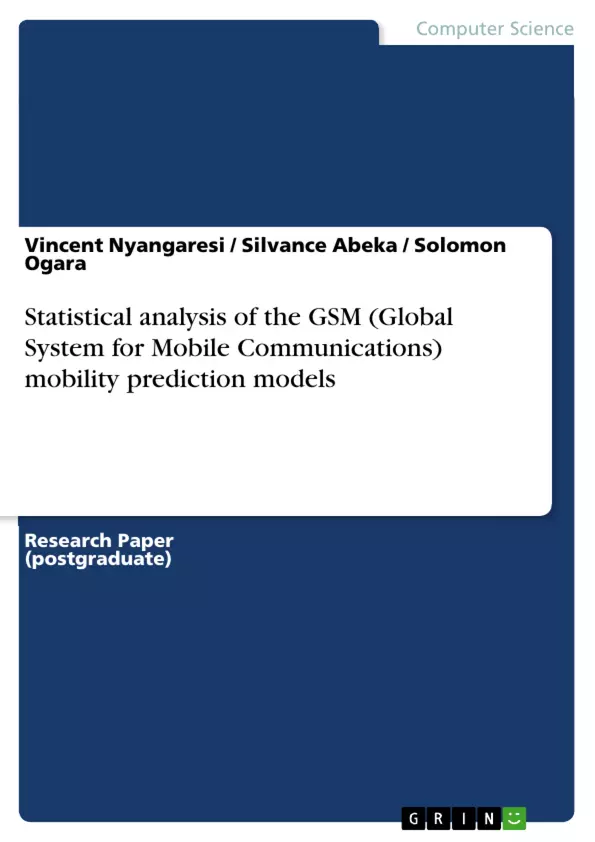In the GSM environment, mobility prediction is concerned with envisaging of the mobile station’s next movement. By accurately employing the predicted movement, the GSM network is capable of attaining enhanced resource allocation and reservations, better assignment of cells to location areas, more efficient paging, and call admission control. Numerous studies have been carried out in mobile station prediction and as such, many mobility predictions have been developed. The goal of this paper was to statistically analyze these mobility prediction models in order to understand their strengths and weaknesses. The results of this analysis indicated that the current mobility models base their predictions on movement patterns of users throughout physical space. However, they do not directly relate to movement throughout the network based on the cell presently hosting a mobile station. In addition, several base transceiver stations may overlap over a single physical location, a complication not captured by the current mobility prediction models. Therefore, there is need for a generic mobility prediction model that can depict movement of mobile users more realistically within the GSM network coverage areas. As such, this paper proposes the development of a mobility prediction model that is capable of accurately reflecting mobile station movement in real-world cellular networks, taking into consideration the actual scenarios such as base transceiver stations overlapping. The requirements for this novel mobility prediction model are also provided, and were based on the shortcomings noted in the existing mobility prediction models. The significance of the proposed model lies on the fact that in order to pre-allocate resources for seamless connectivity during handovers, the mobility prediction model should anticipate the actual cell that the mobile station will next connect to, rather than the physical location they will move to.
Inhaltsverzeichnis (Table of Contents)
- GSM CELLULAR COMMUNICATIONS
- Preamble
- Significance of Mobility Prediction
- GSM MOBILITY PREDICTION MODELS
- Introduction
- Obstacle Mobility Model
- Street Unit Model
- City Area Mobility Model
- Random Walk Model
- Random Waypoint Model
- Markovian Random Walk
- Random Direction Model
- Shortest Path Model
- Normal Walk Models
- Smooth Random Mobility Model
- Microscopic Models
- Mesoscopic Models
- Macroscopic Models
- Reference Point Group Mobility
- Column Mobility Model
- Pursue Mobility Model
- Nomadic Community Mobility Model
- Activity-Based Model
- Cell-Residence-Time-Based Model
- Pathway Mobility
- MOBILITY TAXONOMY ARCHITECTURE
- Introduction
- Taxonomy Development
- Taxonomy Parameters
- GSM MOBILITY MODELS PARAMETRIC ANALYSIS
- Introduction
- Models Based On Location and Fixed Velocity
- High Probability Prediction Models
- Cell to Cell Mobility Models
- Models Based On Feasible Future Sequence of Cells
- Models Based On Degree Of Randomness
- Trace-Based Models
- Constrained Topology Models
- Statistical Models
- Models Based On Level of Description
- Fluid Flow Model
- Gravity Mobility Models
- Models Based On Individual User Behaviors
- Models Based On Nodes Movement Dependency
- Temporal Dependency of Velocity
- Spatial Dependency of Velocity
- Models Based On Real Network Movement Depiction
- CRITIC OF GSM MOBILITY PREDICTION MODELS
- Introduction
- Models Based On Location and Fixed Velocity
- Models Based On High Probability Prediction
- Cell to Cell Mobility Models
- Models Based On Feasible Future Sequence of Cells
- Models Based On Degree of Randomness
- Models Based On Level of Description
- Models Based On Individual User Behaviors
- Models Based On Nodes Movement Dependency
- Models Based On Real Network Movement Depiction
- PROPOSED MOBILITY PREDICTION MODEL
- Introduction
- Requirements for the Proposed Model
Zielsetzung und Themenschwerpunkte (Objectives and Key Themes)
This paper presents a statistical analysis of existing GSM mobility prediction models with the aim of identifying their strengths and weaknesses. The analysis aims to contribute to the development of a novel mobility prediction model that more accurately reflects real-world cellular network scenarios.
- Analysis of existing GSM mobility prediction models
- Identification of strengths and weaknesses of current models
- Proposal for a new mobility prediction model
- Development of requirements for the proposed model
- Focus on real-world cellular network scenarios
Zusammenfassung der Kapitel (Chapter Summaries)
This section provides a summary of the main themes and arguments presented in each chapter of the paper, excluding the conclusion and final chapter.
- Chapter 1: Introduces the concept of GSM cellular communication and the importance of mobility prediction for efficient network resource management.
- Chapter 2: Presents a comprehensive overview of existing GSM mobility prediction models, including their underlying principles and assumptions.
- Chapter 3: Discusses the development of a taxonomy for classifying and comparing different mobility prediction models based on various parameters.
- Chapter 4: Analyzes the various existing models based on their underlying assumptions and methodologies, grouping them into categories based on key parameters.
- Chapter 5: Provides a critical evaluation of the existing mobility prediction models, highlighting their limitations and challenges in capturing real-world network scenarios.
Schlüsselwörter (Keywords)
The key keywords and topics covered in this work include GSM, mobile station, mobility prediction, cellular network, network resource management, and real-world scenarios.
- Quote paper
- Vincent Nyangaresi (Author), Silvance Abeka (Author), Solomon Ogara (Author), 2017, Statistical analysis of the GSM (Global System for Mobile Communications) mobility prediction models, Munich, GRIN Verlag, https://www.grin.com/document/371131



